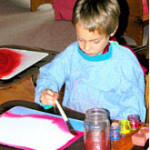 I wonder whether we pay enough attention to the delicate time of transitioning from one thing to the next. Moving from playtime to bedtime can bring on a tantrum. Moving from one job to another… may not bring on a tantrum, but it can be devastating. Moving from an old home to a new one can be soul-shattering. Transitioning from one season to the next can bring on depression, anxiety, exhaustion.
I wonder whether we pay enough attention to the delicate time of transitioning from one thing to the next. Moving from playtime to bedtime can bring on a tantrum. Moving from one job to another… may not bring on a tantrum, but it can be devastating. Moving from an old home to a new one can be soul-shattering. Transitioning from one season to the next can bring on depression, anxiety, exhaustion.
In school, transitions between classes are some of the most challenging. The end of a class is typically marked by the loud clang of a bell and a frantic rush to finish. Students jump to their feet, their spirits jabbed by shards of noise and movement.
Becoming aware of transitions can help us all through our daily lives. Every single thing we do needs a moment of transition. Without that transition, what went before is minimized or lost. Take a kiss, for instance. A kiss that’s ended by a tender look is a totally different experience to one that’s ended by the person who kissed you rushing off. To end a conversation with a friendly smile or an “I understand” is different than ending with a strong, abrupt opinion.
The end of every paragraph has a little bit of white space that gives us time to breathe and absorb the paragraph before.
Personally, I don’t do well when I’m stressed or feeling hectic. From the beginning of my teaching career I learned that in order for me to progress peacefully and strongly into the next class, I needed to end the previous class with quiet breathing space.
This is not an original idea. Some teachers end their class with a verse that all the children say together. Others end with the quiet of journaling; others with silence, and then a chorused ‘goodbye.’ I’m always amazed how Waldorf kindergarten teachers can mark each transition with a simple song. The children grow familiar with the song and know when they hear it that they have plenty of time to say goodbye to the doll, to put the wooden blocks back on the shelf, or to start setting the table for snack. They don’t have to be told class is over: not a word needs to be said. It’s an organic, imitative process, and the children are ready and calmly eager for the next activity.
When it was bedtime for my children I used to sing “Goodnight, My Love” (Ella Fitzgerald’s version) as a transition song:
Good night, my love, the quiet old moon is descending
 Good night, my love, my moment with you now is ending
Good night, my love, my moment with you now is ending
It was so heavenly holding you close to me
It will be heavenly to hold you again in a dream…
As soon as my children heard me sing, they knew it was time to brush teeth, put on pajamas, and get ready for a bedtime story.
_____
Writing Practice – Transitions
Transitions in writing require the same quality of moving smoothly from kiss to parting or from playtime to bedtime. Transitional words and phrases help you establish logical, fluid connections within your writing. They help your reader know what you’ve said and what you’re about the say next. They are links, they are the relationship-builders to the ideas in your argument or your story.
They’ll also help you organize what you’re writing because you’ll become clearer about the sequence of what that is. For example, you might start a new paragraph by saying, “Here’s another instance when …”
Or “On the other hand, some people disagree that…” and your reader immediately knows you’re going to present an opposing view.
In a short story you might begin a transition to a different scene by placing it in a difference place or a new time. But to keep us fully engaged, you’ll want to transition us there. So you’d say, “Several hours later…” or “By the time she arrived night had fallen.” What you’re doing in transition phrases is summarizing (very briefly) what just happened and then bringing your reader into the next scene or idea.
Here are some examples you can try:
If you’re placing your reader in a new timeframe: afterward, at last, during, meanwhile, some time later, recently, at the same time. Avoid “suddenly” since the experience you’re conveying by using that word needs to come from the writing itself.
In a new place: overhead there was a…, underneath stood a… , beside her stood…, beyond that was…, near, far away.
Not so often used in fiction, but essential for expository essays, are word-phrases like consequently, also, in addition to, equally important, furthermore, moreover, nevertheless, on the other hand, indeed. And when you’re illustrating a point use for example or for instance.
When you’re nearing the end, prepare your readers so they aren’t surprised: finally, in conclusion, in the end, on the whole, thus, in summary.
Leave out phrases that are padding and annoying like “I’d like to add here that…” or “let me just say that…” or (my personal favorite peeve): “Needless to say.”
_____
Poetry for Transitions
As a high school teacher, I’ve chosen to use poetry to transition into the end of class. After the lesson is learned, the homework assignment is given, questions answered, and books put away, the students sit quietly waiting for the anticipated poem. Because I do this regularly, without asking or discussing it with them, it takes only takes a few classes for them to take it for granted. I’ve found that teenagers appreciate this moment of stillness more than anyone else I know. Some put their heads on their desks and close their eyes while I recite a poem in utter stillness – before the bell rings. Afterwards they remain quiet, and then they move onto the next thing, feeling centered and ready instead of frantic.
Why a poem, you might ask? Three reasons:
- Poetry matters. I think it’s important for teens to hear poetry, to hear beautiful language, powerful imagery, and get insights into life and feeling. Many teens I know write poems, but often they get caught up in emotional angst. They need to hear the great poems of the masters too.
- It’s healthy. Listening to poetry is quieting, soothing, harmonious, and that breathing space is good for all of us.
- I love poetry. I’ve always loved poems, I can recite many of them by heart. There’s nothing I love more than sharing my passion with these kids.
I don’t know if this is a good idea or a bad one; or whether the kids will remember the poems, or even whether they’ll remember that I did this. All I know for sure is that – at the very least – it makes the transition time more pleasant for all of us.
Here is a small list of favorite poets and a suggested poem – but they all wrote dozens of other poems that would work just as well or better. For instance, for a lively class, instead of Eliot’s “Prufrock” use one of his “Practical Cats” poems.
If I Could Tell You by W.H. Auden
Death Be Not Proud by John Donne
The Love Song of J. Alfred Prufrock by T.S. Eliot
The Road Not Taken by Robert Frost
Hurrahing in Harvest by Gerald Manly Hopkins
Ode to Autumn by John Keats
The Road Through the Woods by Rudyard Kipling
The Secret of the Sea by H. W. Longfellow
Annabel Lee by Edgar Allen Poe
The Guesthouse by Rumi
Ode to the West Wind by Percy Bysshe Shelley
Fern Hill by Dylan Thomas
Self-portrait by David Whyte
This is Just to Say by William Carlos Williams

